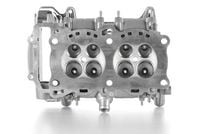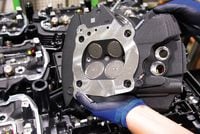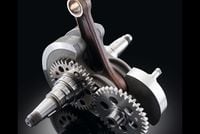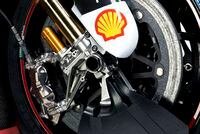Motorcycle Tips By Kevin Cameron
Cycle World's technical editor specializes in performance and engineering
Kevin Cameron has been writing about motorcycles for nearly 50 years, first for Cycle magazine and, since 1992, for Cycle World. Kevin’s unparalleled experience and knowledge of the sport were—and continue to be—prompted by a lifetime of curiosity. His willingness to share that information with anyone who is willing to listen is likewise unique. Kevin’s greatest strength lies in his ability to present complex subjects in simple terms with clarity and, often, humor. As Kevin has written, “Emotions bring us to engineering, but engineering then becomes a special way of confronting reality.”
Motorcycle Engines
Motorcycle engines can take many forms but those most often seen are V-twins, inline-fours, and V-4s. Singles and twins dominate the off-road scene. Sportbike engines spin at high rpm to deliver maximum acceleration, but touring and cruising motorcycles seek wide-range torque at lower revs.
How Does A Motorcycle Engine Work?
The internal-combustion engine is a gun whose barrel is its cylinder and whose bullet is a close-fitting piston, pushed down the barrel by the high pressure of hot combustion gas. In a gun, the hot gas comes from burning gunpowder, but an internal-combustion engine’s cylinder is filled with a mixture of air and evaporated liquid fuel, ignited by a spark. An engine’s apparent complexity comes from the gadgetry that:
- Converts the piston’s straight-line, back-and-forth motion into rotary motion at a spinning crankshaft
- Repeatedly empties the engine cylinder(s) of spent combustion gas and refills them with a fresh fuel/air mixture
The power produced in this way is proportional to:
- How much fuel/air mixture each cylinder can hold, and how many cylinders there are (this is engine displacement)
- How many times per minute the cylinders can be refilled (proportional to engine rpm, or revolutions per minute)
Explore the details in these videos.
Motorcycle Chassis
As once pointed out by former Ducati racing engineer Filippo Preziosi, we know in advance where the wheels must go, the angle of the fork, the positions of the steering head and swingarm pivot, and the necessary location of the engine sprocket. Now all we need is a bracket to hold all these in place. That bracket is the chassis. For years, chassis were made of welded steel tubes, but in the later 1980s the present orthodoxy of twin-aluminum-beam frames came into being. All this seems simple but in the details of where to locate the engine, rider, and fuel—in making chassis stiff enough but not too stiff—are truths that turn out to be temporary, lasting only until the next generation of tires arrives. Above all, the motorcycle’s chassis is a product of interaction between rider and hardware.
Motorcycle Brakes
Any vehicle operating on earth’s surface must be able at will to slow or stop quickly and controllably. The usual tool for this is the dry friction brake, which transforms the vehicle’s kinetic energy (proportional to the square of speed; going twice as fast gives you four times the energy) into frictional heat. The disc brake is a metal disc rotating with each wheel, gripped between friction pads that are applied by hydraulic pressure. When the rider squeezes the lever on the right handlebar, a tiny pump (the front master cylinder) sends up to 400 psi into the brake calipers, forcing the pads against the discs. A foot-operated rear master cylinder sends hydraulic pressure into the single rear caliper. Because braking transfers weight to the front wheel, it is often provided with two discs, while the rear wheel, carrying less weight during braking, has only a single (and often smaller) disc.
Motorcycle Suspension
As a vehicle without suspension moves faster over an irregular surface. Bumps toss its wheels up off that surface faster than gravity—an acceleration of one g—can pull it back down into contact with the road. To improve this situation, we place springs between wheels and chassis. Example: A 30-pound motorcycle wheel supports a load of 300 pounds through a spring. Acceleration in gs is force divided by weight, in this case, 300/30 = 10g. Now when a bump tosses this sprung wheel upward, it is returned to earth by this much higher acceleration. By keeping the tire on the road more of the time, suspension maintains the essential connection between vehicle and road. To prevent the chassis from continuing to bounce after every bump, hydraulic dampers are provided to quickly stop such oscillations. The usual motorcycle suspension at present is a telescopic fork at the front and a trailing arm or swingarm at the rear.
Motorcycle Tires
Engine power, braking, and steering are all helpless without something that can reliably connect the motorcycle to the earth’s surface. We have so far found no material better than rubber—a substance whose elasticity conforms to the texture of pavement or dirt—for this purpose. The flexible pneumatic tire inflated with air allows its tread to flatten against the road, creating a large footprint over which rubber “locks” to road texture. The tire’s carcass gets the strength and rigidity to transmit the forces of acceleration, braking, and cornering from a structure of high-strength fabric comprising rayon, nylon, polyester, or even steel. Although technology that we can see—engines, chassis, and brakes—gets most of the attention, tires have added most to the capabilities of the motorcycle.






/cloudfront-us-east-1.images.arcpublishing.com/octane/PWRH2CI6GNBBTF7J5BMNMH7SQI.jpg)
/cloudfront-us-east-1.images.arcpublishing.com/octane/VHUK3FH6WFHLTHN7CKCATU36LM.jpg)
/cloudfront-us-east-1.images.arcpublishing.com/octane/2OVIGH5Y3JEZLBBPCQAVGUYISM.jpg)
/cloudfront-us-east-1.images.arcpublishing.com/octane/HZPSCAI74NHJJNO7SX3WQXXZC4.jpg)
/cloudfront-us-east-1.images.arcpublishing.com/octane/ZOPSLCZG6JG2JBBIJX4CBY4YRQ.jpg)
/cloudfront-us-east-1.images.arcpublishing.com/octane/QLZQOX5RRBER3IYU2LPKYH4QEU.jpg)


/cloudfront-us-east-1.images.arcpublishing.com/octane/PW7QWH6OKZUV7E3BT552QH7MNM.jpg)
/cloudfront-us-east-1.images.arcpublishing.com/octane/GE7FBIWSLZGDNJJPNDFBPUTIWA.jpg)
/cloudfront-us-east-1.images.arcpublishing.com/octane/T55FJFCMAZCXNI4PV67OIHYOYA.jpg)

/cloudfront-us-east-1.images.arcpublishing.com/octane/BTZGEEQ64NHHLPKQ4HFJCJ2DEQ.jpg)
/cloudfront-us-east-1.images.arcpublishing.com/octane/6JPU4U2H7GOYZH2ZETYQBFLR2Q.jpg)
/cloudfront-us-east-1.images.arcpublishing.com/octane/GC3NMV5YI5DQDP6N6YOVVVEE6M.jpg)
/cloudfront-us-east-1.images.arcpublishing.com/octane/R3JDLDYL2ZGQPF6VCTNMG3QA6Y.jpg)
/cloudfront-us-east-1.images.arcpublishing.com/octane/FQLPGAC6YBC7FHGKKEL3GD55OA.jpg)
/cloudfront-us-east-1.images.arcpublishing.com/octane/2OSY7JZPX5B57KBJ43NYITGUCI.jpg)
/cloudfront-us-east-1.images.arcpublishing.com/octane/GC3NMV5YI5DQDP6N6YOVVVEE6M.jpg)